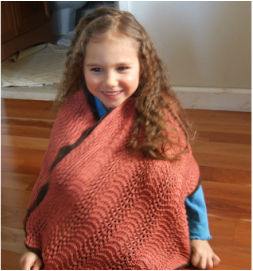
This is my very first design inspired by my aunt Betsa. Tia Betsa learned from her mother, Atanilda, whom we called "La Mamama," and La Mamama learned from her mother, and so on and so on. La Mamama had 12 children, 7 of them girls. All the girl children who survived the early years of life learned to knit, Tia Betsa, however, was the most accomplished knitter of her sisters. She had six children of her own and knit outfits and accessories for all of them throughout their childhoods and later for her numerous grandchildren. Although she had four daughters, none of them learned to knit.
On one of my last trips to Peru, Tia Betsa and I sat down to knit together. Tia Betsa taught me one of her favorite stitch patterns -- pavo real or peacock. This combination of k2togs and yarn-overs create a beautiful peacock fan-tail. It was fun to watch her use her hands in ways very differently than I had learned from my books and videos and she found my hand-movements very amusing! Watching her made me wish I'd learned to knit from family and continued a strong Peruvian tradition, but I was born and raised in the United States and my Peruvian father had no idea how to knit and my Puerto Rican mother specialized in crochet and sewing.
When my family and I returned from this trip, I used this stitch pattern to make a poncho for my daughter, Lucia, when she was five years old. My daughter wore hers often and still does now. Here she is in it when she was five.
When I first started knitting for the kid, I realized that if I knit something her size, she'd outgrow it almost as quickly as it took me to make it. This was why I started designing items that would last and last and last. This poncho also had to survive a very active child, so even though it has some lace holes, the holes are small and have never snagged on anything. And Lucia really gets into things like shrubs and trees and climbs over fences and jumps into leaves and . . . and . . . and.
Given that I also didn't get much rest following this kid around, care for the items I made for her had to be very easy. After a few hand washes, I would put it in my front-loading washing machine in a delicates bag and wash it in cold water. I didn't put it in the dryer. With the Betsa poncho, for sale on this site, I would only put it in the washing machine if it is front-loading and never put it in the dryer.
On one of my last trips to Peru, Tia Betsa and I sat down to knit together. Tia Betsa taught me one of her favorite stitch patterns -- pavo real or peacock. This combination of k2togs and yarn-overs create a beautiful peacock fan-tail. It was fun to watch her use her hands in ways very differently than I had learned from my books and videos and she found my hand-movements very amusing! Watching her made me wish I'd learned to knit from family and continued a strong Peruvian tradition, but I was born and raised in the United States and my Peruvian father had no idea how to knit and my Puerto Rican mother specialized in crochet and sewing.
When my family and I returned from this trip, I used this stitch pattern to make a poncho for my daughter, Lucia, when she was five years old. My daughter wore hers often and still does now. Here she is in it when she was five.
When I first started knitting for the kid, I realized that if I knit something her size, she'd outgrow it almost as quickly as it took me to make it. This was why I started designing items that would last and last and last. This poncho also had to survive a very active child, so even though it has some lace holes, the holes are small and have never snagged on anything. And Lucia really gets into things like shrubs and trees and climbs over fences and jumps into leaves and . . . and . . . and.
Given that I also didn't get much rest following this kid around, care for the items I made for her had to be very easy. After a few hand washes, I would put it in my front-loading washing machine in a delicates bag and wash it in cold water. I didn't put it in the dryer. With the Betsa poncho, for sale on this site, I would only put it in the washing machine if it is front-loading and never put it in the dryer.

 RSS Feed
RSS Feed